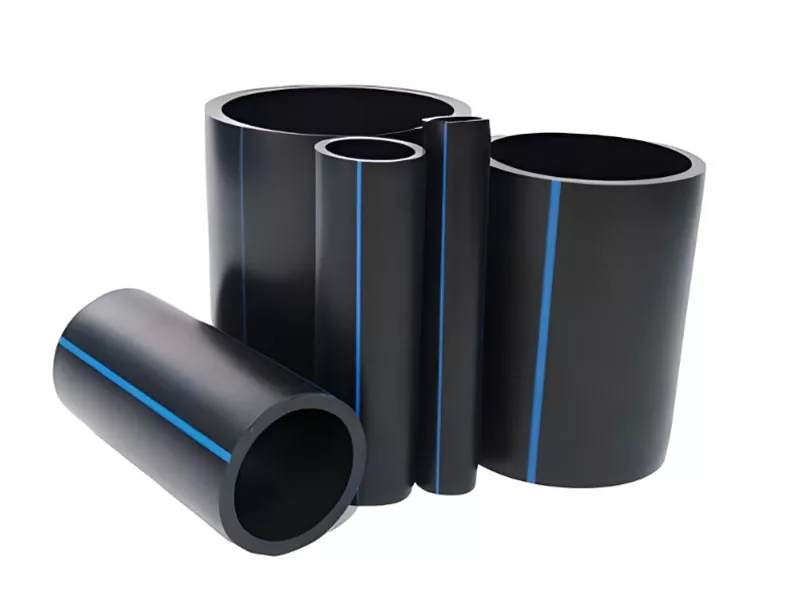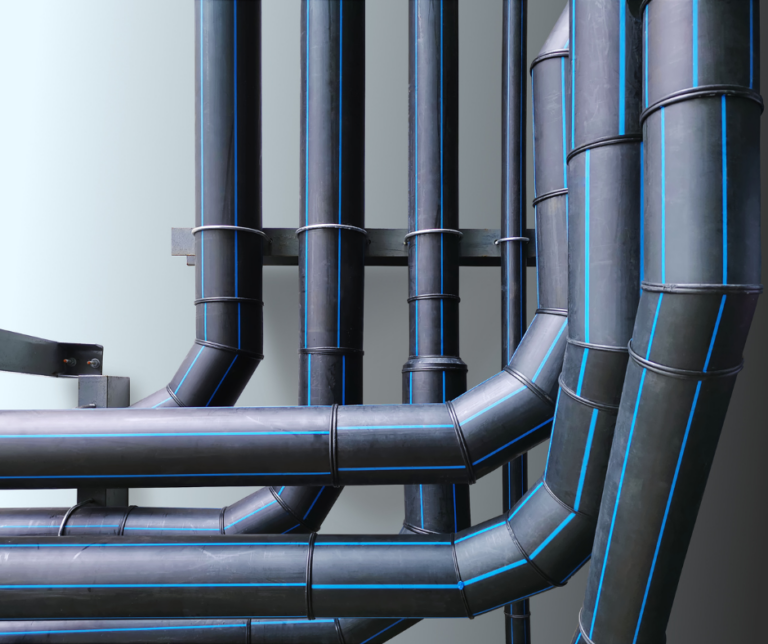Why Partnering with Pipe Supplier American Plastics Midland Ensures Timely Supply
Wiki Article
Discover the Production Refine Behind High-Quality HDPE Pipe and Its Applications
The manufacturing procedure of high-quality HDPE pipes is intricate and systematic. It begins with the selection of raw products that enhance efficiency. Following this, ethylene undertakes polymerization to form material, which is then shaped with extrusion. Quality control is vital, guaranteeing that the last item meets stringent standards. The journey of HDPE pipes does not end with production. Their applications across different markets expose a wider importance worth analyzing.Comprehending HDPE: Features and Advantages

High-density polyethylene (HDPE) is a flexible polycarbonate recognized for its durability and resistance to numerous environmental aspects. This material shows excellent tensile strength, making it suitable for demanding applications. Its low-density structure contributes to a light-weight item, promoting convenience of taking care of and installment. HDPE likewise showcases impressive resistance to chemicals, which decreases degradation when exposed to harsh substances.
The product's low moisture absorption further enhances its durability, making it ideal for use in pipes and storage containers. Additionally, HDPE is immune to ultraviolet (UV) radiation, making sure that items preserve their integrity also when revealed to sunshine. Its adaptability allows for the production of intricate shapes without jeopardizing strength. The eco-friendly nature of HDPE, often originated from recycled products, adds to its appeal, promoting sustainable techniques in manufacturing. In general, these properties and benefits make HDPE a favored choice for numerous commercial and consumer applications.
Resources Selection for HDPE Manufacturing
The selection of basic materials for HDPE manufacturing is vital to verify the last product meets the wanted requirements and quality standards. High-density polyethylene (HDPE) is mainly produced from polymerized ethylene, stemmed from fossil gas such as gas or petroleum. The quality of these feedstocks substantially influences the mechanical and thermal residential properties of the final HDPE.Ingredients likewise play a considerable function in enhancing HDPE's performance, consisting of anti-oxidants, UV stabilizers, and colorants, which enhance longevity and resistance to ecological elements. The selection process should consider not just the chemical structure of the raw products but likewise their handling characteristics to ensure effective production.
The sourcing of raw products need to focus on sustainability and conformity with ecological guidelines, as responsible techniques are critical in today's market. Ultimately, mindful resources option lays the foundation for creating premium HDPE pipes suitable for varied applications.
The Extrusion Refine: Shaping HDPE Pipeline
The extrusion process plays an essential function in forming HDPE pipes, beginning with thorough material preparation techniques that ensure perfect flow and consistency. Just as essential is the layout of the die, which straight affects the last measurements and surface high quality of the pipe. With each other, these factors contribute greatly to the effectiveness and quality of HDPE pipeline production.Product Prep Work Methods
Effective manufacturing of HDPE pipelines begins with careful material preparation techniques, especially the extrusion procedure. During this stage, high-density polyethylene material is very first dried out to eliminate moisture, making certain ideal circulation attributes. The material is after that fed right into the extruder, where it goes through heating and melting, transforming into a viscous state. This heating process is thoroughly regulated to keep the product's stability and performance. The liquified HDPE is forced with a die, forming it right into a constant pipeline kind. Appropriate temperature level management throughout extrusion is important, as it straight affects the product's homes and the last product quality. Once formed, the HDPE pipe is cooled and reduced to specified lengths, prepared for succeeding processing and applications.Die Style Significance
Precision in die style plays a vital function in the extrusion procedure of HDPE pipes. The die serves as the final shaping device, straight influencing the pipeline's measurements, wall surface density, and surface area finish. A well-designed die warranties consistent material circulation, minimizing flaws such as irregularities and vulnerable points. The geometry of the die must be maximized to accommodate the specific residential or commercial properties of HDPE, including its thickness and thermal actions throughout extrusion. Additionally, the cooling price of the material as it travels through the die can substantially affect the pipe's structural honesty. Investing in innovative die innovation is crucial for makers intending to create top notch HDPE pipelines that satisfy sector requirements and client assumptions.Quality Assurance Steps in HDPE Production
Although different variables affect the quality of HDPE pipeline manufacturing, efficient quality assurance steps are crucial to assure consistency and reliability in the final product. Trick high quality control techniques include rigorous material examination, validating that the raw polyethylene meets well-known criteria for pureness and thickness. During the extrusion process, criteria such as temperature level, pressure, and cooling time are stretch hose pipe closely kept track of to preserve dimensional accuracy and structural integrityIn enhancement, post-production screening is essential; suppliers usually carry out hydrostatic tests to assess the pipeline's stamina and resistance to pressure. Visual assessments for surface defects better improve high quality guarantee. Accreditation from appropriate criteria organizations, like ASTM or ISO, supplies an extra layer of reliability. By carrying out these extensive high quality control actions, suppliers can minimize flaws, enhance efficiency, and make certain that the HDPE pipelines meet the details needs of numerous applications, inevitably resulting in client contentment and count on the item.
Applications of HDPE Pipeline Throughout Industries
HDPE pipes are made use of across numerous markets due to their resilience and adaptability. In water circulation systems, they ensure effective distribution, while in wastewater administration, they give reliable solutions for waste transportation. In addition, agricultural irrigation networks profit from HDPE's resistance to deterioration and versatility, making it a perfect selection for modern-day farming techniques.
Water Distribution Equipments
A substantial number of sectors rely upon high-density polyethylene (HDPE) pipelines for efficient water circulation systems. Known for their toughness and resistance to rust, HDPE pipelines are widely utilized in community water system networks, farming watering, and commercial applications. Their light-weight nature assists in easy handling and installation, lowering labor expenses and time. Additionally, HDPE pipes can fit various stress levels, making them ideal for both low and high-pressure systems. American Plastics HDPE Pipe Manufacturing. The versatility of the product enables smooth assimilation into existing infrastructure, minimizing the demand for substantial excavation. Additionally, HDPE's resistance to chemical seeping assurances that the water supplied continues to be safe and clean, making it an excellent selection for keeping the quality of drinkable water throughout numerous fieldsWastewater Administration Solutions
Reliable water distribution systems likewise lead the method for innovative wastewater administration solutions, where high-density polyethylene (HDPE) pipes play a significant function. Distinguished for their resilience and resistance to deterioration, HDPE pipelines are suitable for transferring wastewater in various setups. Their adaptability enables easy setup in complex environments, lessening the requirement for considerable excavation. In addition, HDPE's smooth indoor surface minimizes rubbing, boosting flow prices and efficiency. These pipes are likewise resistant to chemical leaching, making sure that contaminants do not compromise the surrounding atmosphere. Industries, communities, and treatment facilities progressively count on HDPE pipelines for their dependability and durability, making them a preferred option for modern-day wastewater management systems. This versatility underscores the vital relevance of HDPE pipes across many applications.Agricultural Irrigation Networks
Agricultural watering networks profit considerably from using high-density polyethylene (HDPE) pipes, which supply reliable and trustworthy water shipment to crops. HDPE pipes are light-weight, making them easy to transfer and install, while their adaptability enables numerous arrangements in varied terrains. These pipes show excellent resistance to deterioration, chemicals, and UV radiation, making certain resilience in extreme agricultural environments. In addition, their smooth indoor surface area reduces friction loss, optimizing water flow and lowering power prices connected with pumping. The durability of HDPE pipes, often surpassing 50 years, adds to decrease upkeep and replacement expenditures. Subsequently, farmers increasingly depend on HDPE pipelines to improve watering effectiveness and promote lasting farming methods, eventually bring about boosted plant yields and resource preservation.Future Trends in HDPE Pipeline Technology
As the demand for lasting and efficient infrastructure grows, innovations in HDPE pipeline technology are positioned to transform various sectors. Emerging trends consist of the assimilation of wise innovations, such as sensors and IoT capabilities, which promote real-time surveillance of pipeline problems, reducing upkeep costs and avoiding leakages. Furthermore, the growth of innovative production techniques, such as 3D printing, is making it possible for the manufacturing of complex, customized pipe styles that satisfy certain task needs.Furthermore, the focus on recycling and round economic situation practices is driving the innovation of HDPE pipelines made from recycled materials, boosting sustainability. Boosted jointing techniques, such as electro-fusion and mechanical installations, are additionally enhancing installment efficiency and dependability. brake pipe fittings Ultimately, the expanding emphasis on environmental laws is pressing producers to take on greener manufacturing procedures, ensuring that HDPE pipes not only meet industry criteria but additionally foster a more sustainable future for facilities development.
Frequently Asked Questions
Exactly How Does HDPE Contrast to Other Plastic Materials?
HDPE outmatches lots of other plastic materials pertaining to sturdiness, chemical resistance, and adaptability. Its reduced density and high tensile toughness make it excellent for numerous applications, usually exceeding alternatives in both performance and longevity.What Are the Environmental Impacts of HDPE Production?
The environmental effects page of HDPE manufacturing consist of greenhouse gas exhausts, power intake, and prospective contamination from making processes. Furthermore, improper disposal can result in dirt and water contamination, increasing problems concerning long-term environmental impacts.Can HDPE Water Lines Be Recycled?
Yes, HDPE pipes can be reused. Lots of centers accept used HDPE for handling, transforming it right into brand-new products. This reusing adds to sustainability initiatives, reducing plastic waste while preserving sources and energy in the manufacturing cycle.What Is the Life Expectancy of HDPE Piping?

Exactly How Do Temperature Level Variants Influence HDPE Pipeline Performance?
Temperature level variations substantially influence HDPE pipeline efficiency, affecting versatility and stamina. Heats can result in softening, while low temperature levels might trigger brittleness, eventually influencing the pipeline's resilience and suitability for various applications in diverse environments.Report this wiki page